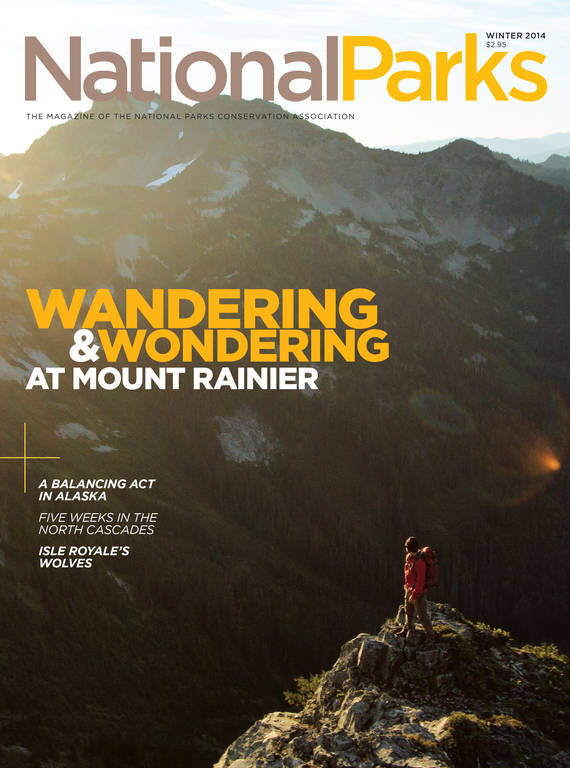Winter 2016
The Mysteries of the Panama Hotel
What treasures did Japanese-Americans abandon when they left for internment camps?
The teahouse nestled below Seattle’s historic Panama Hotel is filled with relics, from Japanese dolls in kimonos to the framed page of a Japanese-American newspaper from the day it ceased publication in 1942. But the most intriguing artifacts are the dusty ones in the basement, which visitors can just make out through a square of plexiglass cut out of the hardwood floor. Under a spotlight, the items look eerie: a trunk, a stuffed basket, some furniture and books, an old handbag. They are but a few of the belongings left here by Japanese-Americans and Japanese immigrants when they were forced—by presidential order—to relocate to internment camps after the Japanese attack on Pearl Harbor in 1941.
The Panama Hotel, a National Historic Landmark, was designed by Seattle’s first Japanese-American architect, Sabro Ozasa. It was built in 1910 on South Main Street in Nihonmachi, or Japantown, and the brick building became a gathering spot for the Japanese immigrant community. With lodging upstairs, doctors’ and life insurance offices on the second floor, and a bookstore, barbershop, and billiards room on the ground floor, it was ahead of its time—not unlike today’s mixed-use properties. The basement’s traditional Japanese-style bathhouse remains the best surviving example of an urban sentō in the United States and looks much like it did when it closed in 1964.
Families believed their belongings could be safely stored at the hotel, and they were. But when the owner, Sanjiro Hori, and his family returned from a camp, they found some internees had died in the interim, and others moved on, leaving much of the luggage unclaimed after World War II. Today, the stories behind many of these items remain unknown, but thanks to a recent $137,000 grant from the National Park Service to inventory, catalog, and photograph the objects, details should begin to emerge this year.
“There are so many unanswered questions, because we’re not 100 percent sure what’s in the suitcases,” said Jacqueline Ashwell, former superintendent of Seattle Area National Park Sites. A historical archaeologist who is now superintendent of the World War II Valor in the Pacific and Honouliuli National Monuments, Ashwell said it’s extremely rare to find a time capsule like the one in the hotel’s basement. (She’s seen just one other in 20 years, an old mining site with miners’ time cards still in the desks.) “It speaks to so many layers of history,” she said. “I wouldn’t be surprised if a lot of the items in those suitcases relate to a Japanese heritage intentionally left behind, but for now, it’s only speculation.”
The grant was awarded to the National Trust for Historic Preservation, which added the hotel to its portfolio of National Treasures in 2015. An inventory of the basement collection will start this winter, and subsequently, the nearby Wing Luke Museum of the Asian Pacific American Experience will research and identify the objects to determine their cultural significance. The goal is to create a searchable database with photos and a description of each item.
Meanwhile, staff at the National Trust are in the process of identifying a new steward for the hotel. The current proprietor, Seattle native Jan Johnson, purchased the building from the Hori family in 1985. She has been a devoted caretaker, establishing the teahouse and fighting to preserve the hotel and its artifacts (including original furniture and tools Sanjiro Hori handcrafted) long before their value was officially recognized. Johnson is ready to pass the torch to another conservation-minded owner who can work with the National Trust to develop a plan for the building and the hotel’s deserted treasures.
It’s the “rare authenticity” of the hotel that’s most compelling, said Sheri Freemuth of the National Trust. “I think all visitors feel like they’re in a place that has experienced some sort of journey,” she said, “whether it’s because of its connection to an immigrant experience or because Jan has given it that vibe, or because of the suitcases in the basement connected to a horrible journey in 1942.”

National Parks
You can read this and other stories about history, nature, culture, art, conservation, travel, science and more in National Parks magazine. Your tax-deductible membership donation of $25 or more entitles…
See more ›These days, Johnson—usually dressed in black, with a ring of keys jangling from her waist—lives at the hotel and largely fills her days with the minutia of inn-keeping. “No wheels on the floor,” she sometimes calls out to guests, referring to luggage on the old leather flooring. She likes to show off the guest room armoires, which her predecessor constructed out of old Frigidaire crates when wood was in short supply after the war.
Johnson came to appreciate history during a trip to Europe she took as a young woman. She has been passionate about preserving the hotel for decades and said she’d like to see the entire basement “plexiglassed off” and turned into a museum. By limiting access to a handful of people over the years, she has helped protect the bathhouse and abandoned belongings.
Some people come to the teahouse as a pilgrimage, occasionally finding family members in the old black and white photos of Japantown residents lining the exposed brick walls. A dozen translations of Jamie Ford’s novel, Hotel on the Corner of Bitter and Sweet, which features an inn based on the Panama Hotel, sit nearby in a glass case.
One visitor, in town from Corvallis, Oregon, last summer, stood by the wall, examining the photos. He said Ford’s book had inspired his visit here. “In 1942, my mother took supplies from Berkeley to a nearby Japanese camp,” he said. “I lived through it, but I was too young to remember.”
About the author
-
 Melanie D.G. Kaplan Author
Melanie D.G. Kaplan AuthorMelanie D.G. Kaplan is a Washington, D.C.-based writer. She is the author of the book "LAB DOG: A Beagle and His Human Investigate the Surprising World of Animal Research" (Hachette/Seal Press, 2025).



